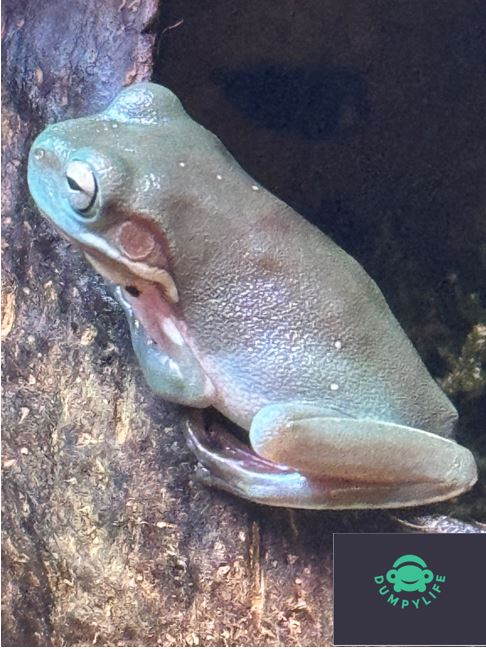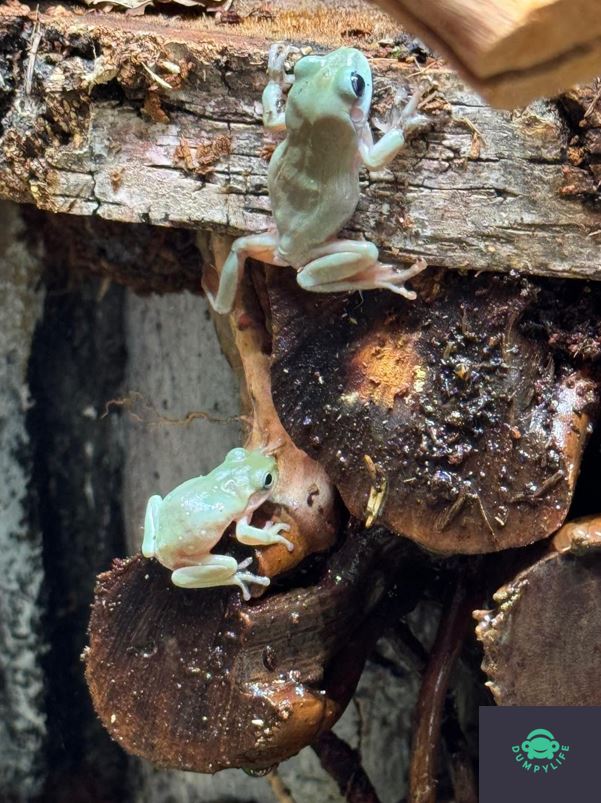Your cart is currently empty!
Coral-toed tree frog/ Dumpy frog (Litoria caerulae)

The coral-toed tree frog/ Dumpy frog or Australian White Tree Frog. The Latin name is Ranoidea caerulea/Litoria caerulea can grow up to 10 cm and reach an age of about 16 years. They originally come from Australia and New Guinea and therefore like a warm, wet and tropical climate.
They are nocturnal animals, so they wake up early in the evening to hunt. Especially males can then start croaking. During the day they look for a cool dark place to hide and sleep. It is important for the frog to stay moist. In dry seasons it has a solution for this. They bury themselves in a kind of cocoon of old skin cells and mucus to stay moist.
They come in different colours, usually bright green, blue-green. But sometimes in stressful situations or wrong temperatures/humidity they colour more brown. The most sold color types on the market:
- Snowflake
- Blue Sandfire
- Blue eyes
- Honey blue eyes
In the blog Our Coral Tree Frogs we introduce our frogs.
They have a vertical pupil because of their nocturnal activity. The belly is often whitish with red/pink spots. They owe their name to their ”sticky legs”. With the sticky legs, with so-called adhesive discs, they easily climb on any surface.
The breeding season starts in November and ends in February. The males will sit at a spot with still water. The eggs will be laid a little above this. This can be up to 2000 eggs. They will then float on the water surface. This takes about a day. Then the eggs will sink. The tadpole period lasts about 6 weeks. Then they will come ashore as young frogs.
The blog about breeding will go into more detail about this.
They mainly eat insects. Crickets in particular are preferred, but they also like grasshoppers and worms now and then. Worms contain a lot of fats and proteins. So don’t give them too much to prevent obesity. Mealworms are also somewhat difficult for them to digest, so they are better off not eating them either. They sometimes even eat spiders and, in the wild, small mammals. The frog’s teeth cannot devour prey, so it must fit well in the mouth. It is sometimes said that whatever fits between the frog’s eyes, it can eat. This seems to me to be a good guideline.
This will be discussed in more detail in the blog Nutrition Dumpy frogs
In terms of housing, they need a high terrarium/paludarium with approximately 55 litres of content per frog. They love to climb, so root branches are definitely a must. The plants must thrive in a humid climate. Bromeliads are a great success here. They have sturdy leaves that they can sleep on or under.
There must be at least a water bowl so that the frogs can bathe. They are not very good swimmers, so make sure that they can always get out of the water easily. The blog Building Paludarium for Dumpy tree Frogs explains step by step how we built the paludarium. Or watch the video below.
The frogs produce quite a bit of droppings, so the design should be to make them easy to clean.
During the day, the humidity should be between 50 and 60%. In the evening, this may gradually increase to 90%. Directly related to this, it is important to have good ventilation and that it is also controllable.
During the day, the temperature is best around 26 degrees. Up to 32 degrees is still possible, but after that it is no longer pleasant for the frogs. The night temperature is best around 22 degrees. With a day/night lamp you can create a rhythm. The night lamp is also recommended, since most activity takes place in the evening and it is better to see then.

